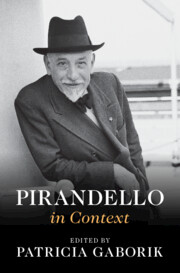Book contents
- Pirandello in Context
- Pirandello in Context
- Copyright page
- Dedication
- Contents
- Figures
- Contributors
- Preface
- Acknowledgments
- Chronology
- List of Cited Titles in Translation and the Original Italian
- Part I Places
- Part II Institutions
- Part III Interlocutors
- Part IV Traditions and Trends, Techniques and Forms
- Chapter 18 Humor
- Chapter 19 Dialect Theatre
- Chapter 20 Metatheatre
- Chapter 21 The Fourth Wall
- Chapter 22 The Anti-Character
- Chapter 23 Myth
- Chapter 24 The Fantastic
- Part V Culture and Society
- Part VI Reception and Legacy
- Further Reading
- Index
Chapter 21 - The Fourth Wall
from Part IV - Traditions and Trends, Techniques and Forms
Published online by Cambridge University Press: 14 March 2024
- Pirandello in Context
- Pirandello in Context
- Copyright page
- Dedication
- Contents
- Figures
- Contributors
- Preface
- Acknowledgments
- Chronology
- List of Cited Titles in Translation and the Original Italian
- Part I Places
- Part II Institutions
- Part III Interlocutors
- Part IV Traditions and Trends, Techniques and Forms
- Chapter 18 Humor
- Chapter 19 Dialect Theatre
- Chapter 20 Metatheatre
- Chapter 21 The Fourth Wall
- Chapter 22 The Anti-Character
- Chapter 23 Myth
- Chapter 24 The Fantastic
- Part V Culture and Society
- Part VI Reception and Legacy
- Further Reading
- Index
Summary
Although Pirandello’s Six Characters in Search of an Author is often taken as an exercise in “metatheatre,” the play in fact imagines theatre defined as a specific technological apparatus: a fully electrified house, actors expected to play “in character,” and an audience spatially and conceptually separated from the artistic performance. That is, Pirandello’s skeptical critique of theatre and theatricality is undertaken through a specific instrument, the apparatus of the modern, darkened proscenium house. This chapter explores Pirandello’s work in the context of a specific kind of technological apparatus, one in which the thematics of critique are specifically managed by the ideological disposition of modern theatre design and signaled most effectively by its tools, notably by the rhetorical assertion of the proscenium as a “fourth wall” and by the ways lighting articulates its function in the making of dramatic performance.
- Type
- Chapter
- Information
- Pirandello in Context , pp. 170 - 178Publisher: Cambridge University PressPrint publication year: 2024

